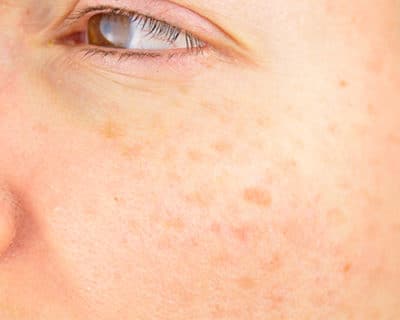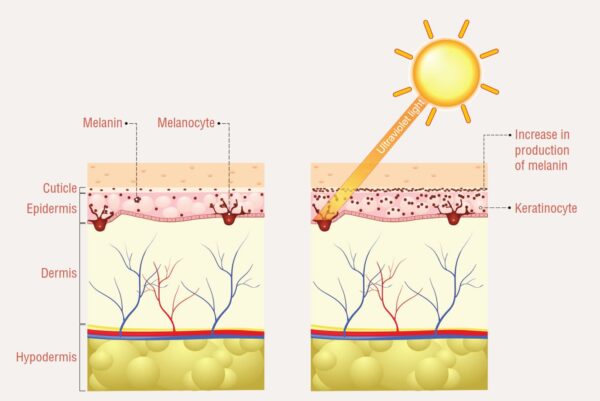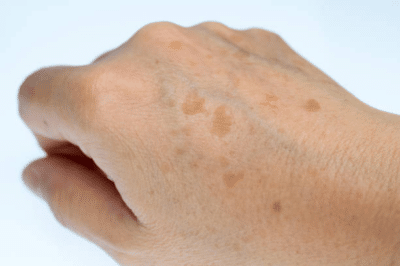
Aged Spots & Sun Spots
Aged spots, sun spots or liver spots, medically known as ‘solar lengitines’, are one of the most common types of hyperpigmentation. Our skin is naturally pigmented due to the melanin created by melanocytes in our skin cells. Hyperpigmentation is essentially excessive pigment being produced which causes patches of skin to be darker resulting in discolouration of the skin.
Areas prone to age/sun spots are the face, shoulders, back of the hands, chest, and neck as these areas often have longer exposure to the sun compared to the rest of the body. These spots can vary in size and shape depending on the individual’s melanin production and sun exposure. However, people with fair skin and ages above 40 are more likely to have solar lentigines.
They can be mistaken for freckles as they are also flat and brown with distinct borders but unlike freckles that can fade during the winter months, solar lentigines do not lighten on their own.
What is the cause of Hyperpigmentation?
The UV rays from sunlight lead to an increase in the production of melanin in the skin which causes hyperpigmentation. Over time this over-produced melanin starts to form clusters underneath the skin which results in a solar lentigo (sun spot/age spot/liver spot). These flat, brown spots become more visible and increase in numbers with time as the damage from the sun accumulate.

Other causes of hyperpigmentation include:
- genetics
- hormonal changes
- medications
- injury such as acne, burns, friction or a side effect of aggressive skin treatments
Is it necessary to remove age spots, sun spots, liver spots?
While most hyperpigmentation spots are harmless and do not have any bodily effects, many people opt for the removal of age/sun spots (or treatment of melasma) for cosmetic reasons. Most age spots are a natural protective response by the skin from chronic sun exposure to better protect the skin from additional damage. Not all hyperpigmentation can be treated equally by a singular mode of therapy. You may require a combination of various treatments and even use take-home products on a daily basis. Your clinician will be able to best advise you on a treatment plan that caters to your skin condition.

Treatment plan tailored to the individual
We would highly recommend that you have a consultation with one of our skin specialists. During your consultation, we can assess your skin, work out a treatment plan that can help address your concerns at a pace and budget that suits you. Your treatment plan will be tailored to you as an individual as we all age differently.
Treatments We Recommend:
Ways to Prevent Further Sun spots or Hyperpigmentation
Protecting the skin from UV rays can help prevent the occurrence of additional hyperpigmentation on your skin. Following a few simple things can help you prevent sun spots such as:
Making Sunscreen a Part of your Skincare Regime
Dermatologists and skin experts often discuss the importance of sunscreen. Make sure to apply sunscreen at least 20 to 30 minutes before you venture out in the sun. Choose the right SPF coverage as per your skin and sun exposure or consult a practitioner. It is also important to choose a sunscreen that protects you from both UVA and UVB radiations. Keep sunscreen handy and reapply it as directed.
Limiting Outdoors Between 10am to 4pm
The sun’s rays are the strongest between 10 am to 4 pm and therefore, limiting your outdoor activities during these hours can help prevent sun spots in the long run.
Choosing the Right Clothing
Whenever possible, make sure your arms and legs are covered with dark-coloured clothes. Dark colours offer higher sun protection as compared to light colours. Wear UV protection sunglasses to protect your eyes from harmful rays.
Following the steps above diligently can often be a difficult task for most people. Luckily there are sun spot treatments available. Depending on the damage, our practitioners might prescribe a combination of sun spot removal creams and sun spot treatment procedures. We conduct a detailed consultation with our patients before going ahead with our treatment plans to ensure all our patients are at ease and know what to expect from the same. Click the links below for information on our treatments to treat skin concerns such as sun spots.